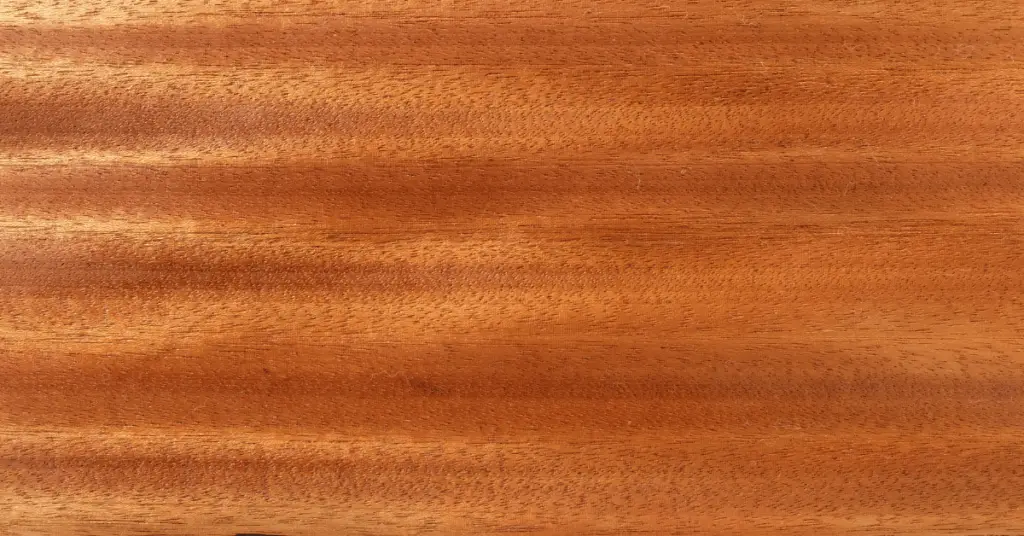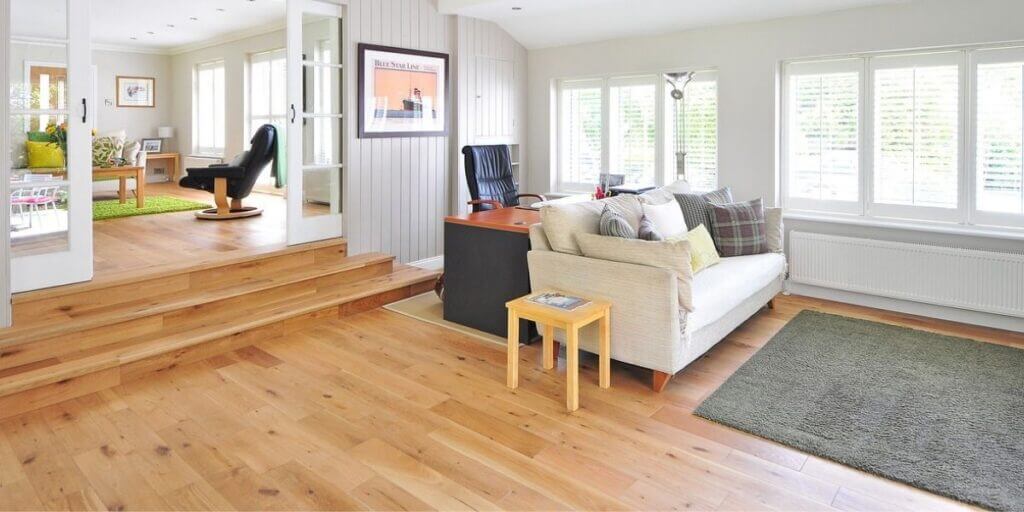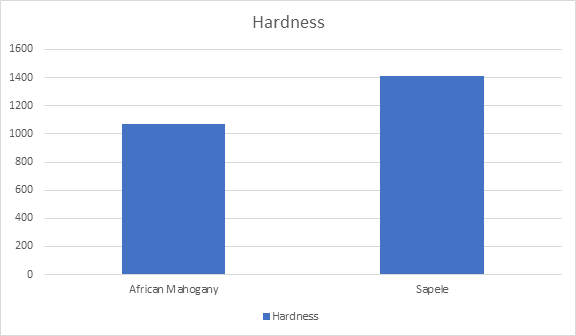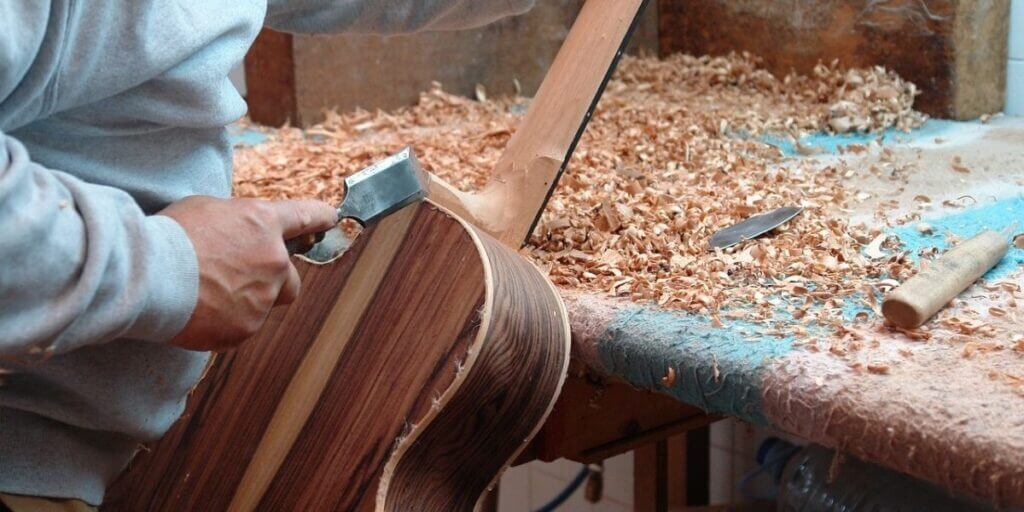The scientific name of Sapele wood is Entendrophragma cylindricum. Sapele wood is used in the manufacture of fine furniture, cabinets, and doors. Sapele is golden to dark reddish-brown in color and becomes darker with age. It is famous for its hardness, dark brown color, and good finishing.
Sapele is also known by other names, sapele or sapele or sapele Mahogany. Sapele gets its name from the town of Sapele in Nigeria. Where there is an abundance of trees. From here, it is exported to other countries of the world. Sapele is important to the economy of Nigeria.

Sapele wood is considered the best alternative to Mahogany. True Mahogany is rare and priced higher. Sapele is very close to Mahogany but not the same as Mahogany. That’s why most people prefer to use sapele instead of Mahogany in some cases, such as making guitars.
Sapele Wood Characteristics
| Sapele Wood Scientific name | Entandrophragma cylindricum. |
| Tree Height | Up to 45 m |
| Average dry weight | 42 lbs. / cu. ft., or approximately 3.5 lbs. per board foot. |
| Janka hardness | 1,410 lbf. |
| Color | Golden to dark reddish-brown or purplish-brown. |
| Height | 45m or more |
| Workability | Average. |
| Bending Properties | It can bend easily. |
| Finishing | Finishes well. |
| Sapele Uses | Furniture, Cabinetry, Flooring, Veneer, plywood, and Musical Instruments. |
What Does Sapele Wood Look Like?
Sapeheartwood is usually medium to dark reddish-brown, and the sapwood is light brown. Its base color can vary, with some pieces appearing light golden or yellow. When freshly cut, sapele wood is often a bright red or orange color, which darkens and darkens with exposure to light over time.
Sapele wood has an interlocked grain pattern. The grain can be straight, wavy or sometimes even curly, creating a visually appealing texture. Additionally, sapele wood often displays a ribbon-like stripe pattern on the surface, which adds to its attractiveness.
Sapele Wood for Outdoor and Indoor Use
The primary use of Sapele wood is for furniture, doors, windows, cabinet work, flooring, applications and musical instruments

1. Guitar Body
Sapele is an excellent choice for making guitar bodies because it has great visual appeal and can be easily peeled into thin sheets, which are used on the sides of the guitar body.
Despite being harder than African mahogany, it can be easily cut and bent. For some new guitarists, this may be the new wood. However, due to the rising price of mahogany and continuous harvesting, Sapele is widely used for musical instruments.
Sapele wood guitar tone is similar to mahogany tone, and the price is also lower, so guitar makers prefer to use Sapele. It isn’t very easy to say who is better. It depends on who listens.
2. Flooring
Sapele is an excellent choice for flooring because it has an attractive appearance, stability, and hardness. Sapele’s toughness protects it from scratches and dents from pointy sandals and furniture legs.
Sapele wood does not require any conservation treatment. This means it is naturally safe for children. Who likes to play on the floor. It is 16% harder than Red Oak, and it is more durable than genuine African mahogany.

3. Boats and Boat Part
Sapele wood is also suitable for outdoor use as it does not change its properties even after constant exposure to water. That’s why it is used to make a lot of boats.
Due to the high cost of Sapele, some boat builders use sapele veneer sheets instead of solid wood, but this can only be done for boat decoration. Solid wood is used to make the base of boats.
4. Cutting Boards
Sapele wood is harder than red oak and genuine mahogany. Also, it can be used without chemical treatment. Yet, it is more durable and is an excellent choice for cutting boards.
Due to sufficient hardness, this knife and other cutting tools do not make marks. Its deep, dark color makes it ideal for personalizing with custom engraving.
5. Door and Windows Frames
Sapele wood also offers an extraordinary appearance along with good stability. It is water and rot-resistant, so it is mainly used for making bathroom ranks, doors, and kitchen cabinets.
6. Beams
Sapele wood is used for Indoor construction elements such as beams and wooden pillars. Its interlocked grain pattern gives it strength. So that this heavyweight can be lifted for a long time without cracking.
Sapele Wood Advantages
1. Extremely Durable
Sapele wood is hard and dense in nature, which makes it durable and stable; hence, it can be used for both indoor and outdoor applications. The durability of this wood can be further enhanced by polishing and painting. Sapele wood furniture can last a long time.
2. Easy Maintenance
Due to its good toughness, it suffers less damage during daily use and requires less care. The biggest problem with flooring is that it is prone to scratches from furniture legs. For such problems, you can use furniture pads, which cause less damage.
3. Appearance
Sapele wood is famous for its appearance and texture. Everyone likes its golden to dark reddish-brown or purplish-brown. Its color gives a rich appearance. Its color darkens over time.
4. Water and Fire Resistance
The most important thing is that this sapele wood is moisture and fire-resistant. It can also withstand water for a long time. It does not expand or shrink even when in constant contact with water.
5. Wood Tone
Sapele wood is also famous for its slightly brighter sound with more top-end shimmer tone. Its tone is almost similar to mahogany wood. It is so similar that some guitarists do not notice any difference in the tone of the two types of wood.
Sapele Wood Disadvantages
1. Cost
Sapele wood can cost more than some other hardwoods. Due to continuous harvesting its reserves are declining rapidly. Sapele is being recovered in Africa. It is expected that its price will reduce in the next few decades.
2. Sensitivity to Sunlight
Like many exotic hardwoods, sapele wood can darken or change color when exposed to sunlight over time. This characteristic might not be suitable for areas with large windows or high exposure to natural light.
3. Difficult to Work
Some experts believe that there is a problem with Sapele operating the machine. Because it has interlock grain. So it makes the work slow. Some carpenters like to work manually. It is much easier to work with small tools than large tools.
How Hard is Sapele Wood?
Sapele wood has a hardness value on the Janka scale of 1,360 lb (6,060 N) and an average dried weight of 41.6 lbs/ft3 (665 kg/m3). Therefore, according to the data, we can say that Sapele wood is moderately hard.
Sapele vs. Red Oak Hardness: Red oak, a typical hardwood in North America, has a Janka hardness rating of 1,290 lb. Which is softer than Sapele.
Sapele vs. Hard Maple Hardness: Hard maple, another popular choice for flooring and furniture, has a Janka hardness rating of 1,450 lb, making it slightly harder than Sapele.
Sapele vs. Mahogany Hardness: Mahogany wood species vary, but generally, African mahogany (Khaya spp.) has a Janka hardness rating of about 830 pounds, while South America’s genuine mahogany (Swietenia spp.) has a Janka hardness rating of about 900 pounds. Therefore, Sapele wood is much harder than mahogany.
Sapele vs. Cherry Hardness: American black cherry, often used in high-quality furniture, has a Janka hardness rating of around 950 lb, making it softer than Sapele.
Working With Sapele Wood

Generally, Sapele wood is easy to work with hand and machine tools, but the interlocked and wavy grain patterns can cause problems during machine operation.
Although the interconnected grains give strength to wood, they can also be challenging to work with for a beginner. Tools become blunt during cutting. The good thing is that due to its high density and hardness, it holds nails and screws well.
Sapele gives excellent results after finishing the wood. It is used to make small items like jewelery boxes and pen holders. Which can be carved easily. This wood species can be easily worked with small tools.
Can You Paint or Stain Sapele Wood?
Yes, the Sapele surface accepts paints and stains well and lasts long. But my experience is that no one would want to cover the beautiful color of sapele with paint. Many people apply stains to get a dark and shiny appearance. As sapele naturally darkens over time, its natural color becomes more prominent.
Is Sapele Wood Good for Outdoor Use?
Yes, Sapele wood can be used for outdoor furniture, as it is moisture and rot-resistant. Sapele’s shape does not change due to weather but is not temperature resistant. Due to continuous exposure to sunlight, rain, and temperature fluctuations, the color of wood becomes discolored.
To increase external durability, Sapele usually requires finishing and regular maintenance.
Sapele Wood Sustainability
The Sapele tree is more common in Africa. When sapele grew in popularity and was used as a substitute for mahogany, logging was undoubtedly a problem, but in West Africa, illegal logging is prohibited, and populations are recovering.
The wood is not listed in CITES but listed on the IUCN Red list because, over the last 3 years, this species has been found to have declined by about 20%. This shortage is due to its constant demand and low production. This also echoes Sapele’s high price.
What is Sapele Engineered Wood Flooring?
Sapele-engineered wood flooring is a composite material comprising multiple layers. Typically, it consists of a top layer made from sapele veneer, providing the natural aesthetic, and underlying layers of plywood or high-density fiberboard (HDF) for stability. Sapele-engineered wood flooring, a popular choice in modern interior design, is crafted from sapele wood.
Read our another article



Comments are closed.